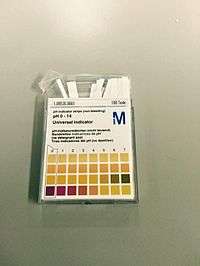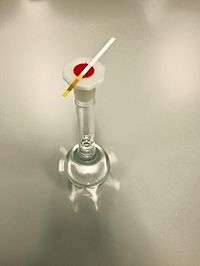Universal indicator

A universal indicator is a pH indicator composed of a solution of several compounds that exhibits several smooth colour changes over a pH value range from 1 to 14 to indicate the acidity or alkalinity of solutions, where 7 indicates neutral. Although there are several commercially available universal pH indicators, most are a variation of a formula patented by Yamada in 1933.[1] Details of this patent can be found in Chemical Abstracts.[2] Experiments with Yamada's universal indicator are also described in the Journal of Chemical Education.[3]
A universal indicator is typically composed of water, propan-1-ol, phenolphthalein sodium salt, sodium hydroxide, methyl red, bromothymol blue monosodium salt, and thymol blue monosodium salt.[4] The colours that indicate the pH of a solution, after adding a universal indicator, are:
| pH range | Description | Colour |
|---|---|---|
| < 3 | Strong acid | Red |
| 3–6 | Weak acid | Orange or yellow |
| 7 | Neutral | Green |
| 8–11 | Weak base | Blue |
| > 11 | Strong base | Violet or Indigo |
The colours from yellow to red indicate an acidic solution, colours blue to violet indicate bases and green colour indicates that a solution is neutral.
| Indicator | Low pH colour | Transition pH range | High pH colour |
|---|---|---|---|
| Thymol blue (first transition) | Red | 1.2 – 2.8 | Yellow |
| Methyl red | Red | 4.4 – 6.2 | Yellow |
| Bromothymol blue | Yellow | 6.0 – 7.6 | Blue |
| Thymol blue (second transition) | Yellow | 8.0 – 9.6 | Blue |
| Phenolphthalein | Colourless | 8.3 – 10.0 | Fuchsia |
Wide-range pH test papers with distinct colours for each pH from 1 to 14 are also available. Colour matching charts are supplied with the specific test strips purchased.
Types of Universal Indicator



A universal indicator is collectively a mixture of indicators which show a colour change in a solution,which interprets how acidic or basic a solution is. A universal indicator can be in paper form or present in a form of a solution.[5]
- Paper form: Is a strip of coloured paper which changes colour to red if the solution is acidic and to blue if the solution is basic. The strip can be placed directly onto a surface of a wet substance or few drops of the solution can be dropped onto the universal indicator using dropping equipment. If the test solution is of a dark colour, it is preferable to use a paper universal indicator.
- Solution: The main components of a Universal indicator, in the form of a solution, are thymol blue, methyl red, bromothymol blue, and phenolphthalein. This mixture is important because each component loses or gains protons depending upon the acidity or basicity of the solution being tested. It is beneficial to use this type of a universal indicator in a colourless solution. This will increase the accuracy of indication.
See also
References
- ↑ Jap. Pat. 99,664, Feb 21, 1933
- ↑ Chem Abstr, 28, 2258 (1934)
- ↑ For a discussion of these experiments, as well as recipes for Yamada's and other universal indicators, see Foster, L. S.; Gruntfest, I. J. (1937). "Demonstration experiments using universal indicators". Journal of Chemical Education. 14 (6): 274. doi:10.1021/ed014p274.
- ↑ "Universal Indicator Archived September 25, 2006, at the Wayback Machine.". ISCID Encyclopedia of Science and Philosophy.
- ↑ Walker, Denise (2007). Acids and alkalis (1 ed.). London: Evans. p. 13. ISBN 0-237-53002-3. Retrieved 4 June 2015.